| PZL-5 | |
|---|---|
 | |
| Role | Sports plane |
| Manufacturer | PZL |
| First flight | May 1930 |
| Introduction | 1930 |
| Retired | 1939 |
| Produced | 1930-1932 |
| Number built | 15 |
The PZL-5 was a Polish two-seat touring and sports aircraft of 1930 constructed and produced by the PZL.
| PZL-5 | |
|---|---|
 | |
| Role | Sports plane |
| Manufacturer | PZL |
| First flight | May 1930 |
| Introduction | 1930 |
| Retired | 1939 |
| Produced | 1930-1932 |
| Number built | 15 |
The PZL-5 was a Polish two-seat touring and sports aircraft of 1930 constructed and produced by the PZL.
The aircraft was designed in 1929 by an amateur designer Władysław Kozłowski. It was a wooden biplane, similar to de Havilland Gipsy Moth. The PZL State Aviation Works in Warsaw took over the design, searching for an aircraft to participate in a contest for a trainer aircraft, announced by the LOPP paramilitary organization (Air- and Anti-Gas Defense League). Kozłowski worked out a documentation, with a help of PZL bureau and fitted the example with a more powerful 100 hp Gipsy I engine, instead of a planned 85 hp version. The first prototype of PZL-5 was built and flown in May 1930, followed by two pre-series aircraft in June 1930, built on the factory's initiative specially for the International Touring Competition 1930 (Challenge) (registration SP-ACW and SP-ACX). [1]
After trials, the design was modified, receiving the designation PZL-5a. Among other changes, the fuselage and wings were shortened a bit, and the nose was modified. The first prototype was rebuilt this way, using a 94 hp Cirrus III engine, receiving the markings: SP-AEE. In 1931, a series of 11 aircraft were built, for aeroclubs' orders. They received markings from SP-AFF to SP-AFP and SP-AGF. Most had Gipsy I engines. [1] A price was 9,600 złoty (£380) for an airframe, plus 14,000 złoty (£560) for a Gipsy I engine. [2]
The PZL-5 was too difficult to fly to be a basic trainer, consequently, a modified variant PZL.5bis was designed and built in 1932. It had a 120 hp Gipsy II engine, longer wings and fuselage, larger cockpit openings, changed tail and landing gear. The only prototype was flown in July 1932. It took part in a contest for the basic trainer aircraft for the Polish Air Force, but it was beaten by the RWD-8. [1]
A further development of the PZL-5bis was the WK-3, built privately by Władysław Kozłowski and flown in 1933. The PZL also proposed in 1930 to build a trainer seaplane under a proposed designation PZL.8 (not to be confused with the PZL P.8), but the Polish Navy was not interested and it was not built. [1]
Wooden construction braced biplane. Fuselage plywood (front) and canvas (tail) covered. Rectangular wings with rounded ends, canvas covered. Crew of two, sitting in tandem in open cockpits with windshields. Cockpits with dual controls (a front cockpit had only basic set of controls). The Flight magazine described the PZL.5 as: a very solid looking edition of a cross between the Avian and a Moth . [3]
Specifications included: 4-cylinder air-cooled straight engine in front: 100 hp de Havilland Gipsy I or 94 hp Cirrus III. Two-blade wooden propeller Szomański of a fixed pitch. Conventional landing gear, with a rear skid. Fuel tank 96 L in upper central wing section. Fuel consumption - 23.5 L/hour. [1]

Two pre-series aircraft took part in the International Touring Competition (Challenge International de Tourisme) in July 1930. Only Ignacy Giedgowd completed the contest flying the PZL.5 SP-ACW, on the 33rd place (for 35 classified and 60 starting crews). [4] Bolesław Orliński had to withdraw in Spain due to engine failure, flying SP-ACX. [1]
A total of 11 PZL-5as and the prototype were bought by local aeroclubs in Warsaw, Katowice, Kraków, Poznań and Vilnius and intensively used for sports, training and touring. Along with pre-series aircraft, they were used in numerous Polish aviation competitions, with some success (for example, 2nd place in the 2nd South-Western Poland Rally in 1930 and the 1st place in the 5th Rally in 1933). [1]
In 1932, SP-ACX was modified to glider towing and fitted with additional fuel tanks, for 8 hours of flight. [1]
SP-AFG was scrapped in 1935, SP-AFH crashed in 1932, SP-AFL crashed in 1935, SP-AFM was damaged in 1933 and scrapped, SP-AFP crashed in 1935. About half survived until 1939, they were longest serving Polish aircraft of wooden construction. Some were bought by private owners. After the outbreak of World War II, SP-ACX was evacuated to Romania. [1]
Data from [1]
General characteristics
Performance
Aircraft of comparable role, configuration, and era

The RWD 5 was a Polish touring and sports plane of 1931, a two-seat high-wing monoplane, constructed by the RWD team. It was made famous by its transatlantic flight, being the smallest aircraft to cross the Atlantic.
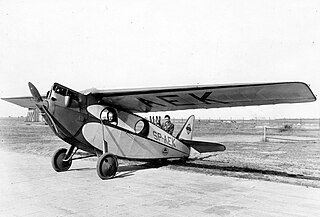
The RWD 4 was a Polish sports plane of 1930, constructed by the RWD team.

The RWD-10 was a Polish aerobatics sports plane, single-seat parasol wing monoplane, used from 1933 to 1939 and constructed by the RWD team.
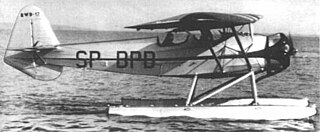
The RWD 17 was a Polish aerobatics-trainer aircraft of 1937, parasol wing monoplane, constructed by the RWD team.

PZL.19 was a Polish sports aircraft built in 1932 in the PZL works. Ordered by the Ministry of Communications, it was specifically designed for the upcoming Challenge 1932 contest held that year in Germany.

The PZL.44 Wicher (gale) was a prototype of 14-seat, twin-engine Polish airliner, built in the Państwowe Zakłady Lotnicze (PZL) in 1938. It was to compete with the DC-2 and Lockheed Super Electra.

PZL.12 (PZL-H) was a prototype of a Polish amphibious flying boat designed and built in 1931 by Zygmunt Puławski, a pioneering Polish designer. He was killed in a crash involving this design.

The PZL.16 was a Polish passenger aircraft, designed in the early 1930s in the PZL in Warsaw. It remained a prototype.
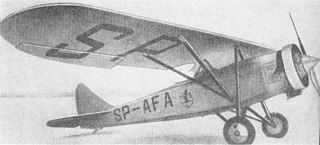
The PZL Ł.2 was the Polish Army cooperation and liaison aircraft, built in 1929 in the Polskie Zakłady Lotnicze (PZL) in Warsaw. Only a small series of 31 aircraft, including prototype, were made, and used by the Polish Air Force in the 1930s. The aircraft was known in Poland for accomplishing of a long-distance tour around Africa in 1931.

The Bartel BM.4 was a Polish biplane primary trainer aircraft used from 1929 to 1939 by the Polish Air Force and Polish civilian aviation, manufactured in the Samolot factory in Poznań. It was the first plane of Polish design put into production.

The PZL.4 was a Polish three-engine passenger aircraft for 10 passengers, built in PZL factory in 1932, which remained a prototype. It was the first Polish-designed and produced multi-engine plane.

The P.W.S.8 was a 1930 Polish sports plane, constructed by the Podlaska Wytwórnia Samolotów (PWS), that remained a prototype.

The RWD 23 was a Polish low-wing trainer aircraft of 1938, constructed by the RWD team, that remained a prototype.

The JD-2 was a Polish sports plane of 1926. It was the first sports plane designed in Poland, that was built in a small series.

The RWD-16 was a Polish two-seat low-wing sports plane of 1936, constructed by the RWD team, that remained a prototype.
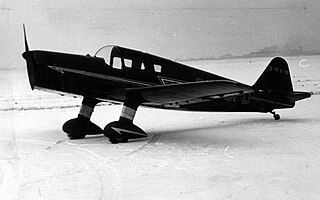
The RWD-19 was a Polish two-seat low-wing sports aircraft of 1938, constructed by the RWD bureau.
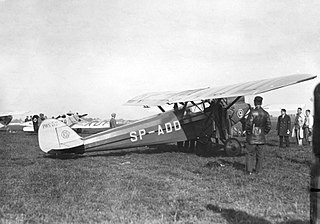
The PWS-52 was a Polish sports aircraft of 1930, a single-engine high-wing monoplane, constructed by the Podlaska Wytwórnia Samolotów (PWS), that remained a prototype.

The PWS-5 or PWS-5t2, was a multi-seated Polish liaison aircraft, developed in 1928 by PWS.
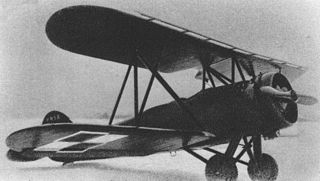
The PWS-6, was a Polish liaison aircraft, developed in 1930 by the PWS, that remained a prototype.

The PWS-11 was a Polish aerobatic and trainer aircraft, developed in 1928-1929 by PWS, which remained a prototype.
Notes
Bibliography
| Wikimedia Commons has media related to PZL.5 . |